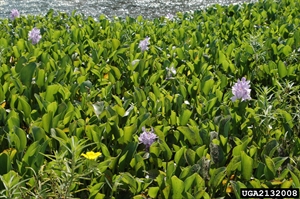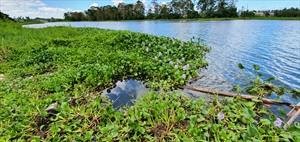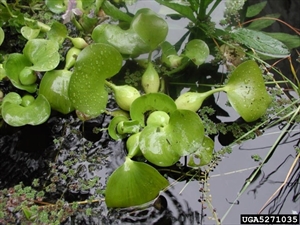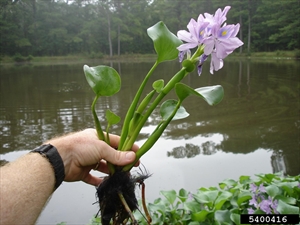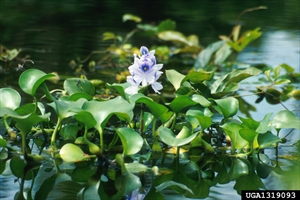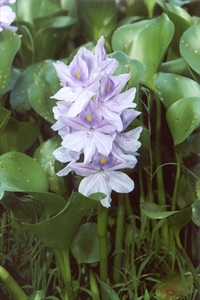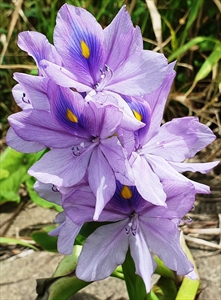- Widespread. Asia, Africa, North, South and Central America, Caribbean, Oceania. In many Pacific islands.
- Invasive weed of slow-flowing water: rivers, swamps, ponds, lakes, dams, lagoons. Growth extremely rapid, forming dense mats, reducing flow, preventing transport, destroying natural wetlands, waterways, indirectly killing native fish, plants and birds (oxygen starvation), and forming breeding sites for mosquitoes. High nutrient levels affect growth.
- Free-floating, up to 65 cm tall. Stems just on or under water produce daughter plants. Leaves, dark green, rounded leaf blades, up to 15 cm wide. Leaf stalks swollen when uncrowded, unswollen when crowded. Flowers (5-20), on erect stalk, about 15 cm long, each with six parts, lilac to blue with yellow spot. Fruit capsule beneath each flower with up to 300 seeds. Seeds germinate on shorelines. Roots up to 1 m, feathery:
- Spread: rapid vegetative reproduction; seed, by wind, boats; use as aquatic ornamental.
- Biosecurity: high risk of introduction via aquarium trade In Australia, 'restricted invasive plant': do not release into environment, give away or sell. Among 100 of World's Worst Invasive Alien Species (IUCN, 2020). Noxious weed in Fiji. Available on internet.
- Biocontrol: two weevils, Neochetina eichhorniae and Neochetina bruchi; three moths, Niphograpta (Epipagis) albiguttalis, Xubida (Acigona) infusellus and Bellura densa; a mirid, Eccritotarsus catariensis; a mite Orthogalumna terebrantis, and several fungi.
- Cultural control: check nutrient levels (important); floating booms; manual removal (rakes), or mechanical harvesting and crushing.
- Chemical control: in Australia: 2,4-D; glyphosate; metsulfuron-methyl. In Fiji, MCPA.
Pacific Pests, Pathogens and Weeds - Online edition
Pacific Pests, Pathogens, Weeds & Pesticides
Water hyacinth (455)
Water hyacinth
Eichhornia crassipes. It was known previously as Eichhornia speciosa. It is a member of the Pontederiaceae.
AUTHORS Grahame Jackson & Aradhana Deesh
Adapted from Water hyacinth (Eichhornia crassipes) (2018) Weeds of SE Qld and Northern NSW. Lucidcentral. (https://www.lucidcentral.org/editors-pick-animal-and-plant-identification-keys/key-to-weeds-of-se-qld-and-northern-nsw); and additional information from Water hyacinth Eichhornia crassipes Department of Agriculture and Fisheries Biosecurity Queensland (https://www.daf.qld.gov.au/__data/assets/pdf_file/0005/54680/water-hyacinth.pdf); and CABI (2019) Eichhornia crassipes (water hyacinth). Invasive Species Compendium (https://www.cabi.org/isc/datasheet/20544); and from Waterhouse DF, Norris KR (1987) Biological Control Pacific Prospects. Inkata Press, Melbourne. Photo 1 Karen Brown, University of Florida, Bugwood.org. Photo 2 Chris Evans, University of Illinois, Bugwood.org. Photo 3&4 Leslie J. Mehrhoff, University of Connecticut, Bugwood.org. Photo 5 Ted D. Center, USDA Agricultural Research Service, Bugwood.org. Photo 6 Graves Lovell, Alabama Department of Conservation and Natural Resources, Bugwood.org. Photo 7 Josh Hillman, FloridaNature.org, Bugwood.org.
Produced with support from the Australian Centre for International Agricultural Research under project HORT/2016/185: Responding to emerging pest and disease threats to horticulture in the Pacific islands, implemented by the University of Queensland, in association with the Pacific Community and Koronivia Research Station, Ministry of Agriculture, Fiji.

